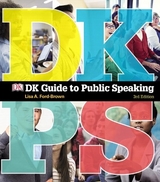
DK Guide to Public Speaking
Pearson (Verlag)
978-0-205-93013-5 (ISBN)
- Titel erscheint in neuer Auflage
- Artikel merken
With its powerful visual design and comprehensive scope, the DK Guide to Public Speaking, 2/e, is an easy-to-navigate resource that will equip students with the tools to be effective public speakers. Based on extensive research and usability studies, this full-color, tabbed, spiral-bound guidebook gives students the practical information they seek, supported with the concepts and theories instructors want.
MyCommunicationLab is an integral part of the Ford-Brown program that will help enhance students’ presentation skills. With MediaShare, students can post and share videos of their speeches for peer commenting and instructor commenting and grading. Also, interactive videos provide students with the opportunity to evaluate speeches. Online self-assessments and pre- and post-tests help students assess their comfort level with public speaking and their knowledge of the material.
Note: This is the standalone book, if you want the book/access card order the ISBN below:
0205980929 / 9780205980925 DK Guide to Public Speaking Plus NEW MyCommunicationLab with Pearson eText -- Access Card Package
Package consists of:
0205890857 / 9780205890859 NEW MyCommunicationLab with Pearson eText -- Valuepack Access Card
0205930131 / 9780205930135 DK Guide to Public Speaking
TAB 1: Starting
Chapter 1: Overview of Public Speaking
Using the skills
The process of communicating
Be a successful public speaker
Overcome a fear of public speaking
Be an ethical public speaker
The creative process for public speaking
Learning with this book
Chapter 1 Review
Chapter 2: Getting to Know Your Audience and Situation
Why you need to know your audience and situation
What you need to know about your audience
Traits to investigate
What you need to know about the situation
Analyze the audience and situation
Adapt to your audience and situation
Chapter 2 Review
Chapter 3: Selecting Your Topic and Purpose
Select a topic
Narrow your topic
Create a central idea
Construct a working outline
Chapter 3 Review
Practical Pointers for Tab 1
TAB 2: Researching
Chapter 4: Locating Support Materials
The Internet
Using the Internet to access libraries
The library
On the Internet and in libraries
Interviews
Surveys
Researching effectively
Chapter 4 Review
Chapter 5: Selecting and Testing Support Materials
Types of support materials
Determine types of sources to use
Evaluate support materials
Use materials effectively
Cite sources orally
Chapter 5 Review
Practical Pointers for Tab 2
TAB 3: Creating
Chapter 6: Outlining Your Speech
Parts of an outline
Create an effective outline
Types of outlines
Link your speech parts
Cite sources in your outline
Create a source page
Chapter 6 Review
Chapter 7: Organizing the Speech Body
Organizational strategies
Make a speech out of a strategy
Chapter 7 Review
Chapter 8: Introducing and Concluding Your Speech
What an introduction should do
Attention-getters
Organizing an introduction
What a conclusion should do
“WOW” statements
Organizing a conclusion
Chapter 8 Review
Practical Pointers for Tab 3
TAB 4: Presenting
Chapter 9: Using Language Successfully
What makes language important
Using language effectively
Boosting your distinctiveness
Chapter 9 Review
Chapter 10: Delivering Your Speech
Elements of vocal delivery
Elements of physical delivery
Methods of delivery
Preparing for an extemporaneous speech
Preparing for a mediated presentation
Chapter 10 Review
Chapter 11: Using Presentation Aids
Types of presentation aids
Determine what presentation aids you need
Methods for displaying aids
Crafting an effective aid
Using presentation software
Using aids successfully
Chapter 11 Review
Practical Pointers for Tab 4
TAB 5: Listening & Evaluating
Chapter 12: Listening
Why listening is important
The process of listening
Types of listening
What can prevent listening
Helping your audience listen
How you can listen more effectively
Chapter 12 Review
Chapter 13: Evaluating Speeches
Why evaluation is important
Evaluating speeches
Who evaluates your speech
Chapter 13 Review
Practical Pointers for Tab 5
TAB 6: Speaking to Inform
Chapter 14: The Informative Speech
The process for informative speaking
What informative speaking is
Choose an informative topic
Research the informative speech
Construct an informative outline
Organize the body of the speech
The introduction and conclusion
Sample preparation outline for an Informative speech
Prepare to present your speech
Evaluate an informative speech
Chapter 14 Review
Practical Pointers for Tab 6
TAB 7: Speaking to Persuade
Chapter 15: Tools for Persuading
What persuasive speaking is
What a persuasive speech should do
Traditional appeals
Modern appeals
Parts of an argument
Types of arguments
Chapter 15 Review
Chapter 16: The Persuasive Speech
The process for persuasive speaking
Choose a persuasive topic
Research the persuasive speech
Construct a persuasive outline
Organize the body of the speech
The introduction and conclusion
Sample preparation outline for a persuasive speech
Prepare to present your speech
Evaluate a persuasive speech
Chapter 16 Review
Practical Pointers for Tab 7
TAB 8: Speaking on Special Occasions
Chapter 17: Speeches for Special Events
The process for special occasion speaking
Special occasion speech purposes
Writing a special occasion speech
Types of special occasion speeches
Chapter 17 Review
Practical Pointers for Tab 8
TAB 9: Speaking in Professional & Group Settings
Chapter 18: On-the-Job Speaking
Creating a business presentation
Communicating in a meeting
Communicating in an interview
Communicating in a review
Chapter 18 Review
Chapter 19: Speaking in Small Groups
What a small group is
Roles in a small group
How groups make decisions or solve problems
How groups present findings
Chapter 19 Review
Practical Pointers for Tab 9
| Erscheint lt. Verlag | 7.2.2014 |
|---|---|
| Sprache | englisch |
| Maße | 100 x 100 mm |
| Gewicht | 100 g |
| Themenwelt | Sachbuch/Ratgeber ► Beruf / Finanzen / Recht / Wirtschaft ► Briefe / Präsentation / Rhetorik |
| Schulbuch / Wörterbuch | |
| ISBN-10 | 0-205-93013-1 / 0205930131 |
| ISBN-13 | 978-0-205-93013-5 / 9780205930135 |
| Zustand | Neuware |
| Haben Sie eine Frage zum Produkt? |
aus dem Bereich



